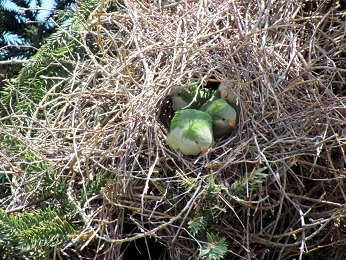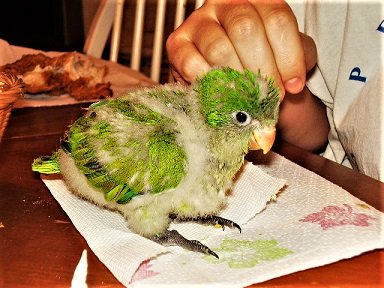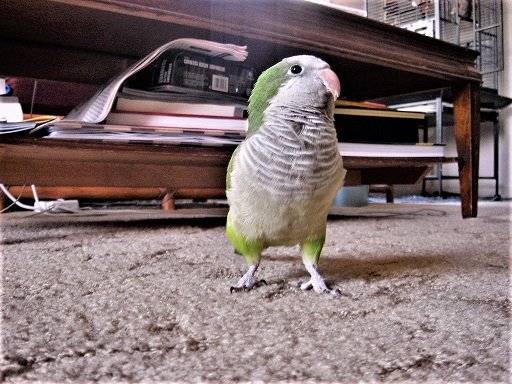Quaker parrots are extremely popular among bird-lovers due to their cuteness and numerous skills they possess. The personality of a Quaker varies from individual to individual though. There are many factors to be considered before bringing a Quaker home.
Sometimes you prefer to buy a specific gender. You may not be ready to take care of the female Quaker because you do not want her to lay eggs during the breeding season. Or, you might be planning to build an aviary and looking to get a pair for it. In such cases, it is required to determine the Quaker’s gender before you make him a part of your family.
Quaker Parrot Gender Determination
All Quaker parrots look very similar to each other, especially when they are young. There is no physical distinction between a male Quaker and a female one. It is said that female Quakers tend to be 10-20% smaller than the male Quakers. But you cannot tell about their gender just by observing them this way. There are some methods that can help you determine their gender with surety.
How to determine gender?
DNA Testing
There are two different ways to take a sample from your Quaker parrot for DNA testing, blood sample, or by a feather.
Here is Lab that does testing for Quaker parrots in the UK:
https://www.easydna.co.uk/bird-dna-test/
“Avian DNA based sexing is the ultimate in testing for birds. Our test starts at only £95. Distinguishing male from female birds is notoriously difficult. Unlike mammals, the physical characteristics which distinguish male and female birds are very subtle or altogether absent. Bird DNA sexing can help breeders establish the gender of the birds with 100% accuracy. “
For blood tests, The vet will take a blood sample from his leg which will be sent to the laboratory for further examination. It will tell you the gender of the Quaker along with complete information about his well-being.
Another method to get his DNA test report includes feather plucking. Pluck a few feathers from the Quaker’s body and send them directly to the DNA laboratory for determining his gender. Be careful with feather plucking since it causes irritation to the Quakers and they are exposed to developing an infection with that.
Surgical Test
Surgical testing was widely used to determine the Quaker’s gender before DNA testing became commonly accessible. As both genders possess different reproductive organs, this method checks the organs of your Quaker. Its use has been limited due to its invasive nature. In this method, Quaker is given anesthesia to reduce pain during surgery. A small area of his abdomen is shaved and an incision is made into it. To examine his reproductive organs, the expert passes an endoscope through the incision made. It is a completely accurate method to know the bird’s gender but can be a little stressful for the bird. Proper after-surgery care is also required towards cleaning the incision area to prevent an infection.
How not to determine gender
Hip Bone
It is believed that Quaker parrot’s gender can be determined by touching the hip bone. Female Quakers have wider hip bone due to the provision for accommodating eggs while their male counterparts have a narrow bone. But it is not an accurate method to determine their gender as some male Quakers also develop a wide hip bone.
Monomorphic
In almost all the parrot species, one can tell the difference between a male and a female just by looking at them. Usually one is smaller than the other and there are major variations in their colors and feathers. But in the case of Quaker parrots, both genders are very similar in their appearance. Such species are known as monomorphic species. Their size, color, feathers, and body language is completely identical. Therefore, even an expert pet shop owner cannot determine the gender of a Quaker just by observing his physical traits.
This has certainly become an important parameter for many Quakers to decide if their bird is male or female. Normally, a Quaker may start breeding from the age of 2 years. And when the pet Quaker doesn’t lay eggs for many years beyond that, the owners are assured that their bird is male. But there have been instances where a bird has laid eggs at the age of 5 years or even at 10 years of age and has shocked the owners. So, a female Quaker shouldn’t be assumed male just because she has not laid eggs.
Quaker Parrot Gender Myths Busted:
When one decides to make Quaker an addition to the family, a lot of pondering is done on the gender of the bird. To many, the gender of the bird doesn’t matter at all. But to others, especially in this era where there is so much information, reliable and unreliable, bringing a male Quaker is better than a female one or the other way around. And all these biases towards a particular gender has their roots in just hearsay and not in any scientific reasoning. So, let us bust all those possible bubbles here-
1.) Males are more talkative.
This surely is a myth. Developing has more to do with the owners than the Quaker himself. If the owner puts in his time and effort in teaching his Quaker words and vocabulary, then any Quaker will be a great talker. Where would even a male bird learn if he’s not being taught to? Forget about having a male or female Quaker being a better talker, your Quaker would not be able to speak a word unless being trained to.
2.) Males are more affectionate.
This one’s a myth too. Many Quaker owners bring these little birds in pairs to keep this social bird in a company. But they forget that just like every human being, these birds also have a personality of their own. Whether your bird will be affectionate towards you more or less depends on the bond the bird will develop over time with you.
3.) Females are more aggressive.
They are not. It is believed that when kept in pairs, a female Quaker is more aggressive out of both sexes. Aggression has nothing to do with the sex of the bird. It is more related to the general behavior of an individual bird. Also, there could be many underlying factors of aggression like hormonal changes, bad health, unsound sleep, loneliness, territorial interference inside the cage or even a dirty cage for that matter; and any of these reasons can impact a male and a female Quaker alike.
4.) Males are more social.
Another myth needs to be busted. Quakers are inherently very social and outgoing irrespective of gender. Just as in humans, few of us are introverts and other extroverts, birds also have different characters. But those already owning Quakers start basing their personalities on their genders which is certainly the wrong way. Female Quakers are also outgoing and curious alike.
5.) Females are more cuddly.
Let’s bust this myth too. They are not. Many Quaker owners have contributed to this myth by claiming their female bird being more cuddly out of the pair. There is also an extension to this myth that a female Quaker will be more cuddly towards the male owner and the male bird towards the female owner. That claim is senseless in itself as feeling like cuddling is a subjective matter.
6.) Males are insensitive.
That myth is insensitive in itself. A little silent bird being insensitive, male or female, is a pointless thing to say. Many Quaker owners claim that male Quaker parrots are quite insensitive and don’t learn from their mistakes. If they are told not to repeat their mistakes, the male Quakers don’t pay heed to it. But that certainly is not the case. The truth is, if your Quaker, irrespective of the gender, do something you don’t like, just make him clear through your actions a few times. Once he gets it, he will not repeat it, no matter what.
7.) Females want nests more.
This is certainly a myth. Making a nest is exclusive to Quakers when it comes to whole parrot species. Both males and females, at a very early age, start making their dream house; their nest. It is a wrong notion to believe that only female Quaker is more involved. They might divide their duties while in the wild, like male Quakers bringing the essential material for nest-building by flying to the far off places. But when kept as pets at home, it won’t matter if you have a male or a female Quaker, they will start hoarding objects from around the house to build their dream nest.
More about Quaker Parrot Nests in this article:
https://parrotsinfo.net/quaker-parrot-nest/
8.) Put male and female Quaker to get an offspring.
This is just another myth. Quakers are monogamous and stay loyal to one mate all their lives. They take their own time and sometimes when it comes to choosing their mates, Quakers are quite selective and they don’t mate with simply any opposite sex. They never mate until they start liking their partner. Absence of affection and love implies no mating at all, even if both sexes are in the same cage. So, simply keeping a male and female Quaker together will not produce offspring as they only give birth to a ‘love child’.
9.) Only males bob their heads to gain attention.
Just another myth busted. It is said that when in the wild, male Quakers bob their heads to attract the female or simply to get her attention. And this inherent nature of males bobbing and dancing persists in the cage while at home also, which certainly is not true at all. Any Quaker pet, male or female is known to bob their head to get the attention of their owner. The act is just one of the many antics of this little birdie’s playful nature and is not at all gender-specific.
10.) Males and females wag their tails only in a particular manner.
This one’s another myth. During extreme hormonal changes, Quakers wag their tails. And as per an ‘educational guess’, if a Quaker wags his tail briskly side to side, he is bound to be a male and if that tail wagging is from upside down, she is surely a female. But such a sex determination test is hardly logical.
11.) Females need mating to lay eggs.
This is a myth. Many of us don’t introduce male Quakers in our female Quaker’s cage to prevent breeding. But that is not the case. A female Quaker doesn’t necessarily need to mate to lay eggs, mating is just one option of many. If she gets perfect ‘breeding conditions’, she might lay eggs anyway. These conditions could be the length of the day, intake of specific foods, or rainfall. Having a male Quaker is just one of such conditions.
12.) Only males regurgitate food.
This is yet another myth. Let us try to understand what regurgitation is. When a male likes female, he feeds female from his beak or simply regurgitates, to be affectionate with her and he does this with his owner, in case he feels like showing affection to him. But, as against the general belief, this behavior does not depend on gender.
13.) Males have distinct markings.
Lastly, and sadly, this one’s also a myth for those who had already determined their little birdie’s gender just by seeing certain anatomy markings on his body. Such markings around the neck or the body is not at all exclusive to males.
Everything you need to know about Quaker parrot –check our comprehensive guide.
Quaker parrot pair duties:
A Quaker pair is a match made out of love and affection for each other. And they spend their lives together by carrying various household duties together or individually just like us humans. Few of their duties are gender-exclusive and then there are few which they share like any other pair or couple. Understanding them a little more will help us to see beyond their gender and shower them, well-deserved love.

Male Quaker Duties
1.) When in the wild, a male Quaker takes the responsibility of bringing food each day when the female is busy incubating the eggs. And inside the cage, he takes care of female Quakers’ eating by feeding her from his beak.
2.) When in the wild, a male Quaker also brings all the essential material like twigs, tree shavings or branches for building their dream nest. And inside the cage, he is proactive in collecting nesting material.
Female Quaker Duties
1.) A female Quaker has a natural duty of laying eggs and spending most of her time incubating them to hatch young ones from them.
2.) A female Quaker also takes a greater part in nest maintenance after she gives birth to the young ones. As the male Quaker takes the outdoor duty of gathering building material, the female Quaker takes the ‘at home’ duty of maintaining the nest.
Quaker parrot Couple Duties
1.) A Quaker couple shares the duty of incubating the eggs laid by the female Quaker. It is not the duty of females only, even the male bird will help his mate in incubation which continues for about 24 days.
2.) After the young ones are hatched from the eggs, they are raised and taken care of by both the male and female Quaker alike. It is not only the duty of mother Quaker to raise their baby.
3.) After solely focusing on raising the baby Quaker together until one month, the Quaker pair starts the maintenance work on their nest. They enjoy doing this activity together as a couple.
Conclusion:
Love is unconditional. Never, we shower love on someone for what they are, but only for who they are. Quakers are these little birds who are accustomed to living in the wild. Bringing them home and making them adapt to the rules of your house just like other family members, solely depends on how good you are as a Quaker parent. It surely doesn’t depend on if you brought a male or a female home.
If your Quaker is less talkative, more aggressive, less affectionate or maybe more social, it is completely subjective. It depends on how a bird is raised, and how his personality formed accordingly. Just like us humans, Quakers also have varied personalities. Each Quaker is an individual on his own. And if knowing the gender is important because you are not ready to take the responsibility of more additions to the family later on by the female Quaker, you can always take precautions to prevent it simply by educating yourselves.
Your decision to add this little birdie to your family should solely be based on whether you will be able to give him all the love and affection which any family member would want. Planning the gender of the Quaker before bringing him home is like planning the gender of our baby before he’s even conceived. Isn’t it a bit unfair to deny love and family to someone just because he is someone, he didn’t choose to be.



